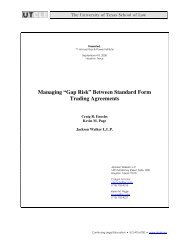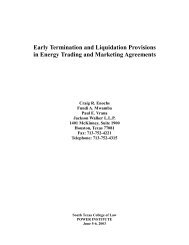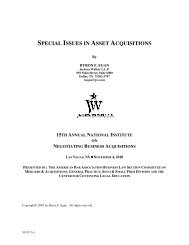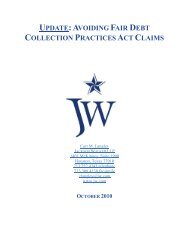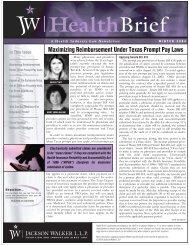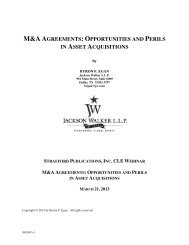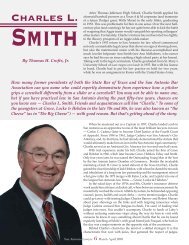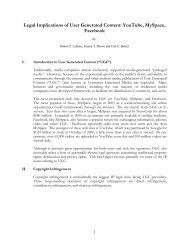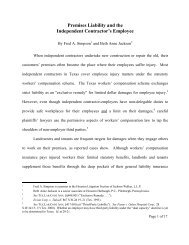asset acquisitions - Jackson Walker LLP
asset acquisitions - Jackson Walker LLP
asset acquisitions - Jackson Walker LLP
Create successful ePaper yourself
Turn your PDF publications into a flip-book with our unique Google optimized e-Paper software.
316 A.2d 599 (Del. Ch. 1974) (<strong>asset</strong>s representing 41% of net worth but only 15% of grossrevenues held not to be “substantially all”); Katz v. Bregman, 431 A.2d 1274 (Del. Ch. 1981)(51% of total <strong>asset</strong>s, generating 44.9% of gross sales, held to be “substantially all”); andThorpe v. Cerbco, Inc., 676 A.2d 436 (Del. 1996). For a comprehensive discussion of theDelaware cases, see BALOTTI AND FINKELSTEIN, THE DELAWARE LAW OF CORPORATIONSAND BUSINESS ORGANIZATIONS, §10.2 (1997). In Story v. Kennecott Copper Corporation,394 N.Y.S. 2d 253, Sup. Ct., 1977 the court held that under New York law the sale byKennecott of its subsidiary Peabody Coal Company, which accounted for approximately55% of Kennecott’s consolidated <strong>asset</strong>s, was not a sale of “substantially all” Kennecott’s<strong>asset</strong>s requiring shareholder approval even though Peabody was the only profitable operationof Kennecott for the past two years.Difficulties in determining when a shareholder vote is required have led some statesto adopt a bright line test. TEX. BUS. CORP. ACT ANN. arts. 5.09 and 5.10 provide, inessence, that shareholder approval is required under Texas law only if it is contemplated thatthe corporation will cease to conduct any business following the sale of <strong>asset</strong>s. See theanalysis of TEX BUS. CORP ACT ANN. arts. 5.09 and 5.10 in Egan and Huff, Choice of Stateof Incorporation --Texas versus Delaware: Is it Now Time to Rethink Traditional Notions?”,54 SMU Law Review 249, 287-290 (Winter 2001), attached as Appendix B. A 1999revision to the Model Business Corporation Act (“MBCA”) excludes from the requirementof a shareholder vote any disposition of <strong>asset</strong>s that would not “leave the corporation withouta significant continuing business activity.” MBCA § 12.02(a). The revision includes a safeharbor definition of significant continuing business activity: at least 25 percent of the total<strong>asset</strong>s and 25 percent of either income (before income taxes) or revenues from pretransactionoperations.If shareholder approval is required, the buyer may want to require that it be obtainedbefore or contemporaneously with execution of the <strong>asset</strong> purchase agreement if that ispossible. Although the buyer can include a no-shop provision (see Section 5.6 of the ModelAgreement) in the acquisition agreement, the seller may want a fiduciary out to the no-shopprovision, and with or without a fiduciary out provision, there is the possibility that theshareholder vote will not be obtained if a better offer comes along before the vote is held.Moreover, without an adequate fiduciary out, the no-shop may be invalid. See Ace Limitedv. Capital Re Corp., No. Civ. A 17488, 1999 WL 1261372 (Del. Ch. Oct. 28, 1999). Thatcase involved a publicly held company, but the courts have not generally made a distinctionbetween publicly and closely held companies in discussing directors’ fiduciary duties.The parties should consider the applicability of the Securities Act and state securitieslaws to the Contemplated Transactions notwithstanding receipt of the requisite shareholdervote. Ordinarily a sale of <strong>asset</strong>s, even if it involves the sale of a business, to a sophisticatedfinancial buyer who will use the <strong>asset</strong>s as part of a business which it will manage and controldoes not implicate the registration provisions of the Securities Act. The inclusion of thePromissory Note as part of the Purchase Price (see Section 2.3) may, however, result in theContemplated Transactions involving the sale of a security requiring structuring to complywith the Securities Act and applicable state securities laws. See Section 3.31 and the relatedComment.Section 3.2(b) contains the Seller’s “no conflict” representation. The purpose of thisrepresentation is to assure the Buyer that, except as disclosed in the Disclosure Letter, theacquisition will not violate (or otherwise trigger adverse consequences under) any legal orcontractual requirement applicable to the Seller or either Shareholder. In connection with3148166v1- 73 -




